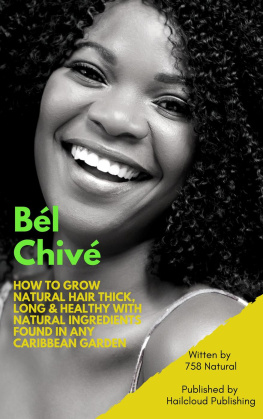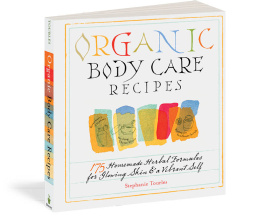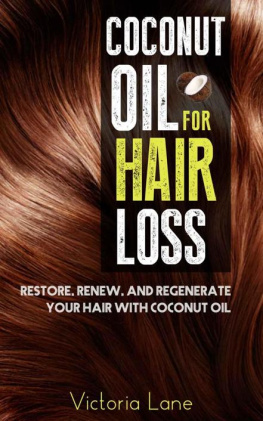Welcome to Goodbye Frizz, Hello Manageable Hair: 25 DIY Tea & Herbal Hair Rinse Recipes for Soft & Glowing Natural Hair.
To thank you for your purchase, youre entitled to a special giveaway.
Introduction
Thank you for grabbing a copy of this Goodbye Frizz, Hello Manageable Hair book!
Do you want to get rid of bad hair days?
Have you always experienced messy and tangled hair?
Do you always reach for a hat or any hair cover for that matter whenever someone takes your picture, lest be mocked?
Do you often struggle combing your hair, which makes you want to cut them all out?
If you answered yes to any (or all) of those questions, then this book is for you. Dont worry; those moments will all come to an end, and will make sure that you have great hair, all day, every day.
This book is made to (hopefully) stop your bad hair days, and make your everyday life feel like youve gone straight out of a shampoo commercial. Tangle-free hair, manageable strands yes, they are possible through herbal and tea rinses.
Herbal and tea rinses are ideal if you wish to go natural for your hair. No unknown chemicals, no harmful ingredients. With herbal and tea rinses, you clearly know whats getting onto your head literally.
Herbal and tea rinses are all filled with mild and safe ingredients perhaps all of which can be found inside your kitchen cabinets. Making them is so easy too; the processes are almost the same for every recipe, all giving you glamorous hair.
Seems too good to be true? Maybe, but not really. Theres one thing thats true, though - that you wont find out how it works until you try.
What are you waiting for? Flip the next page and start reading.
This book has seven chapters, each with its own discussion about herbal and tea rinses.
Heres a brief outline of this book:
Teas: Different Types, Different Kinds
This chapter is all about teas what they are, and how they came about. This also discusses different tea varieties as well as the characteristics of each.
Whats the Right Herb for My Hair?
For every hair type, theres a corresponding herb that will make it better. This chapter will teach you which herb will that be, and how you can use that herb for your hair. Whether your hair is dry, oily, or just normal with needs of its own, there will always be a right herb for your hair.
Basic Types of Hair Rinses
There are two basic types of hair rinses: the ACV or apple cider vinegar rinse, and the plain vinegar rinse. This chapter discusses both types as well as their similarities and differences. You can also find recipes for each type, should you want to concoct your own at the comfort of your home.
Herbal Rinses
This chapter Herbal Rinses will give you a brief background about them definition, ingredients commonly used, and what good do you get out of using them. It will give you an idea why you should create the recipes youre about to find on the next chapter.
Herbal Rinse Recipes
After reading the goodness of herbal rinses, its just understandable that youd like to try them out yourself. Therefore, the next chapter will be filled with easy recipes for herbal rinses.
Tea Rinses
Tea rinses are quite similar to herbal rinses, but of course theyre made with your favorite tea. In this chapter, youll find what tea rinses are, what ingredients are commonly used, and what benefits do you get out of using them.
Tea Rinse Recipes
You cant leave tea rinses behind there has to be a chapter for tea rinse recipes, dont you think? After learning what they can do for you, its just right to create your own rinse and try them out yourself.
Where to Buy Herbs and Teas
No matter how hard you wish your hair to be better, you cant proceed to the next step if you dont have your ingredients on hand. In this chapter are suggested places and sites where you can buy your herbs and teas. Check them out and see why they are ideal places to grab your ingredients from.
Now that you have an idea of what the next chapters will bring you, its now time to prepare yourself to learn more about herbs and teas, and to understand how to prepare herbal and tea rinse recipes.
Teas
Different Types, Different Kinds
Next to wa ter, tea is the most consumed beverage in the world. It can be found on most US households served hot, iced, flavored, on its own, anytime, anywhere.
This aromatic drink is prepared by pouring hot or boiling water over cured leaves of the Camellia sinensis plant.
Most of tea plants are grown in mountainous areas roughly 3,000 to 7,000 feet above sea level. They are grown in acidic and mineral-rich soil in between the Tropic of Cancer and Tropic of Capricorn. Biggest producers of tea include Argentina, Tanzania, China, Taiwan, India, Indonesia, Malawi, Kenya, Sri Lanka and Japan.
How Tea Was Discovered
Tea was discovered by a Chinese emperor named Shen-Nung. According to legends, there were tea leaves that accidentally got into the Emperors pot of boiling water.
After originating in China where it was mainly consumed as a medicinal drink, soon, there were tea drinkers who drank it for recreation during the Tang Dynasty. Tea drinking then spread to other East Asian countries.
It first came to Europe during the 16th century through Portuguese priests and merchants. Drinking tea then became a fashionable activity through the Britons in the 17th century, and had begun large-scale tea production and commercialization in India to stop the Chinese tea monopoly.
This drink has been present for more than 500 decades, and has evolved into a new element the tea bag. Tea drinking, because of its benefits, is believed to stay for a long time.
DIFFERENT TYPES OF TEA
To those who arent oriented with tea, theres more to tea than hot and iced. There are various tea types to choose from. Each kind has its own aroma and taste, suited to fit the palates of tea drinkers worldwide.
Heres a guide to the different tea types:
Black Tea
This variant is the most common in the world. The leaves of the black tea are first allowed to wither completely before they undergo full oxidation. Referred to as red tea in China, younger black tea leaves are picked before they wither, and then rolled, oxidized and fired.
The oxidation results to the leaves dark brown and black color, their more pronounced and robust flavors, and their higher caffeine content (when brewed appropriately).








